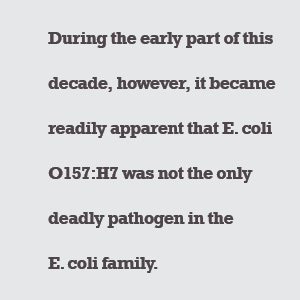
|
This, of course, is with good reason. That outbreak left more than 650 persons ill (many with life-long complications) and four children dead.
The “9/11 for the food industry” precipitated a whirlwind of events including media coverage, consumer outrage, lawsuits and stricter federal regulations regarding meat safety. Though the swell of emotion that spiraled out of the Jack in the Box disaster dulls somewhat with each passing year, the federal regulations that sprung up in its wake continue to generate more questions.
To understand the significance of these regulations, a little background information is useful. The stated mission of the Food Safety & Inspection Service (FSIS) renders it “responsible for ensuring that the nation’s commercial supply of meat, poultry, and egg products is safe, wholesome, and correctly labeled and packaged.”
FSIS operates as part of the USDA. To promote its mission, FSIS has the power under the Federal Meat Inspection Act (FMIA) to, among other things, seek the recall of products that have been deemed “adulterated.” FSIS drastically shifted how it interpreted and enforced the FMIA in 1994 when, following the Jack in the Box outbreak, the agency declared E. coli O157:H7 to be an “adulterant.”
This marked a dramatic change from its previous stance that pathogens in raw meat were not adulterants.
The declaration of E. coli O157:H7 as an adulterant was met with strong opposition from the meat industry. In a lawsuit filed soon after the 1994 declaration, the industry accused the FSIS of not following proper rulemaking procedures and of acting in an arbitrary and capricious manner beyond its legal authority.
The United States District Court held, however, that the FSIS was allowed to interpret the FMIA and that the FSIS has the power to declare substances to be “adulterants” with the intended purpose of spurring the meat industry to create and implement preventative measures.
According to the Centers for Disease Control (CDC), E. coli O157:H7 causes 73,000 illnesses and 50 deaths every year in the United States. Another six E. coli strains — O26, O45, O111, O121, O145 and O103 — are considered less pervasive, sickening “only” an estimated 37,000 people a year and killing nearly 30.
E. coliO157:H7 is considered an adulterant in beef by the USDA (particularly ground beef); the other six strains are not.
Under 21 U.S.C. § 601 ... (m), the Federal Meat Inspection Act (FMIA), the term “adulterated” … :
“… shall apply to any carcass, part thereof, meat or meat food product under one or more of the following circumstances: (1) if it bears or contains any poisonous or deleterious substance which may render it injurious to health; but in case the substance is not an added substance, such article shall not be considered adulterated under this clause if the quantity of such substance in or on such article does not ordinarily render it injurious to health …”
It is hard to read the above and not think that the word “adulterated” does not apply to all E. coli. Presently, industry does not test for all of them (well, Costco and BPI do) because the USDA and FSIS have not traditionally required it — because, until recently, they have not been considered “adulterants.” In addition, only five percent of labs in the U.S. routinely test for these other E. coli leaving a gap in our food-safety network and the true level of illness unknown.
Non-E. coli O157:H7 EHECs have been found in ground beef: In 2008, Marler Clark hired a private lab to conduct a large-scale nationwide study of ground beef, a key vector in E. coli O157:H7 cases. During 2008 and 2009, that lab tested just over 5,000 samples from a variety of manufacturers. IEH Laboratories found that about one percent of the samples were tainted by E. coli O26, O45, O111, O121, O145 and O103. The results and the testing methodology have been shared with USDA and FSIS and the beef industry.
During the early part of this decade, however, it became readily apparent that E. coli O157:H7 was not the only deadly pathogen in E. coli family — in fact, far from it. The CDC recognized this fact when, in 2000, the agency made all EHECs nationally notifiable. The CDC subsequently referred to non-O157 EHECs as emerging pathogens that pose a significant health threat, with more strains reported every year.
Still, FSIS remained steadfast in its stance that O157:H7 is the only EHEC that should be deemed to be an adulterant. So what was wrong with FSIS’s position regarding E. coli O157:H7?
The simple answer is this: The people of this nation do not deserve another Jack in the Box-sized catastrophe as a prerequisite for currently needed agency action.
The scientific and medical communities have recognized the dangers of all EHECs, not just O157:H7. Nearly three years ago, on October 17, 2007, the CDC, FDA and FSIS even went so far as to hold a public meeting to consider the public-health significance of non-O157 EHECs. In the Notice of the meeting, FSIS referred to the “growing awareness that EHEC’s other than E. coli O157:H7 cause sporadic and outbreak-associated illnesses.”
Nevertheless, following the meeting, FSIS failed to re-interpret its policies.
This brings us to today. We’re nearing the end of 2011, closing in on 19 years since the Jack in the Box outbreak. Millions of Americans have suffered foodborne illnesses, injuries and deaths in that time, thousands of them likely due to EHECs other than E. coli O157:H7.
It was on behalf of those persons that in 2009 the law firm of Marler Clark authored a petition to FSIS requesting the agency to issue an interpretive rule declaring all EHECs to be adulterants within the meaning of the FMIA. The petition details the scientific and legal bases for the requested action, but perhaps more importantly, it details the suffering that food contaminated with non-O157:H7 E. coli inflicted upon three individuals: June Dunning, Megan Richards and Shiloh Johnson.
Ms. Dunning, whose infection was caused by E. coli O146:H21, unfortunately succumbed to her illness, passing in 2006. Ms. Richards and Miss Johnson endured lengthy hospitalizations, kidney failure, and will both endure a lifetime of medical complications as a result of their E. coli O121:H19 and E. coli O111 infections.
On September 13, 2011, Secretary of Agriculture Tom Vilsack and Under Secretary of Food Safety Dr. Elisabeth A. Hagen stepped to the microphone and declared that starting March 5, 2012, six more E. coli strains, O26, O45, O111, O121, O145 and O103, would be deemed adulterants. It doesn’t matter whether the response was brought about by the previously mentioned petition, or the simple need to do the right thing for public health. The fact that science moved ahead of politics is a good thing.
It would be naïve to assume that a change to FSIS policy will immediately rid the world of all foodborne E. coli infections. It has been unequivocally proven, however, that all EHECs are potentially lethal pathogens that we must fight tooth and nail to keep out of this nation’s food supply.
If we trust science and do our part to push government agencies to enact regulations to require better monitoring, we can no doubt begin to prevent further harm.
In the end, after all, the requisite wading through the mess of bureaucracy required to change federal regulation is all worth it, so long as the outcome prevents at least one more case like that of June Dunning, Megan Richards, or Shiloh Johnson.



Report Abusive Comment